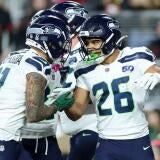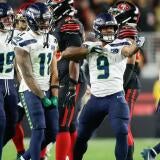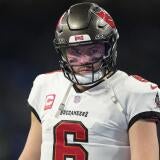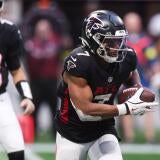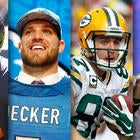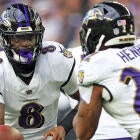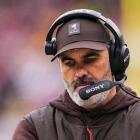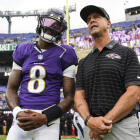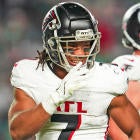NFC North offseason exit interview: 3 good things, 3 bad things for each team
The Bears solve their LB issues, the Pack gets Jordy back and the Vikings draft their perfect receiver

The roster-building portion of the NFL offseason is all but over. Your favorite team's lineup is pretty much set, with the big names in free agency all snatched up and the 2016 NFL Draft in the books.
How did your favorite team do addressing its biggest needs heading into May and June OTAs? We're taking a team-by-team look with offseason exit interviews for each division. We kicked off our look around the league with the NFC East and now it's time to jump into the NFC North.
| ||||||||||||||||||
Three positives1. Kyle Long moves back to guard For all the mistakes ex-GM Phil Emery made (see: Shea McClellin), his decision to draft Kyle Long in the first round of the 2013 NFL Draft is sure helping his successor. Long immediately stepped in at guard as a rookie and flourished, using his athleticism and toughness to dominate in the running game. He was so good and flashed so much potential during his first two seasons that the new regime in town, led by GM Ryan Pace, moved him to right tackle. Long didn't flop as a tackle -- he experienced his ups and his downs -- but he wasn't dominant. Because the Bears signed right tackle Bobby Massie, Long will be moving back to guard, which he announced on Twitter in a unique way.
And that means the Bears offensive line just got that much better. Last year, right guard was a position of weakness for the Bears (Vladimir Ducasse started 11 games). With Long back, right guard should become a position of strength again. 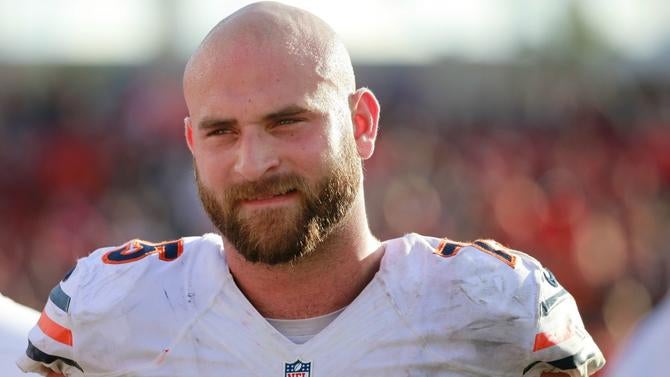 2. A revamped inside linebacker group It took Pace one offseason to turn perhaps the worst inside linebacker group into arguably the best unit in the league. Last season, defensive coordinator Vic Fangio -- who brought over his 3-4 defense to replace the Bears' traditional 4-3 approach -- worked with converted linebacker Shea McClellin and Christian Jones. An example of their work: This year, he'll insert Danny Trevathan and Jerrell Freeman into those spots. Trevathan led the Broncos in combined tackles last year and Freeman finished as Pro Football Focus' highest-graded linebacker against the run. 3. A real backup quarterback When Jay Cutler missed a game last year due to a hamstring injury, Jimmy Clausen stepped in. The Bears punted on every single possession in his one start. Seriously.
The Bears have a funny history with backup quarterbacks -- Todd Collins was an actual thing, Caleb Hanie single-handedly ruined a playoff-bound season, and Josh McCown experienced so much success some fans wanted him to permanently replace Cutler. Brian Hoyer, who the Bears signed this offseason, should provide the team with some much needed stability in the event Cutler hits a snag. Cutler hasn't played in all 16 games since 2009. So this was a real area of need for the Bears. Hoyer and his 82.2 passer rating is a solution to that problem.
Three negatives1. The departed: Adam Gase, Martellus Bennett, and Matt Forte are gone The Bears are on the rise, but they lost three key contributors on offense this offseason. Adam Gase, the coordinator who managed to bring out the best in Cutler, landed in Miami as a head coach. Martellus Bennett, one of the league's most complete tight ends, is now paired alongside Rob Gronkowski (which gives New England the scariest tight end combination in the league). Matt Forte rejoined Brandon Marshall with the Jets. None of those losses were unexpected, but how the Bears will replace those three individuals is a bit of an unknown. Chicago promoted quarterbacks coach Dowell Loggains to offensive coordinator, which should help with continuity, but that doesn't guarantee success for Cutler sans Gase. Loggains' previous stint as an offensive coordinator with the Titans in 2013 didn't go particularly well, as the team finished 22nd in yards and 19th in points. As for their tight end problem, the Bears are banking on Zach Miller to remain healthy. Miller caught five touchdowns last year, including this one-handed game winner, but he has a history of missing entire seasons with injuries. To replace Forte, the Bears tried to steal C.J. Anderson from the Broncos, but failed in that endeavor. So, they'll use a committee that likely includes Jeremy Langford and rookie Jordan Howard. Langford struggled with productivity last season, averaging a league-worst 2.7 yards per carry against base defenses, according to Pro Football Focus. 2. The secondary is still suspect The Bears had a great draft, using it to upgrade their lines on both sides of the ball, but they failed to solve their secondary problem. The Bears will be relying on third-year cornerback Kyle Fuller, who has been remarkably inconsistent in his career, and Tracy Porter, who experienced a bit of a bounce-back season in 2015, but will turn 30 this summer. Remember: This is a team that faces Aaron Rodgers twice a year. And the secondary is their worst position group. The Bears recorded eight interceptions last year -- tied for the second-lowest total in the league.
3. Where's Alshon Jeffery? Soft-tissue injuries ruined Alshon Jeffery's 2015 season. He appeared in just nine games. As Jeffery's own quarterback said last season, those injuries are typically the player's fault.
So, consider it moderately alarming that Jeffery hasn't been training with the team during voluntary offseason workouts. And John Fox doesn't seem especially pleased with his absence. When healthy, Jeffery is Cutler's most-trusted target and is one of the top playmakers in the league. But if the injuries resurface, Jeffery will earn the dreaded injury-prone label. It also might affect his contract talks with the Bears.
| ||||||||||||||||||
| ||||||||||||||||||
Three positives1. The signing of Marvin Jones Marvin Jones is a really good player, who's steadily improved every season. And the Lions signed him this offseason.
The Lions signed him by throwing $20 million guaranteed at him. Some might say the Lions overpaid for him, but Jones is a really darn good player, even if he's not a No. 1 wideout. This doesn't result in a completion, but it's an example of his skill set that should be used more frequently in Detroit:
The team lost Calvin Johnson this offseason (more on this later), so wide receiver clearly was a position of need. The Lions signed arguably the best available wideout.
2. Jim Bob Cooter was retained The Lions started off the season with a 1-7 record. After their bye week, they went 6-2. One big reason for the turnaround was Jim Bob Cooter, who commandeered the offense when the team fired Joe Lombardi after the seventh game of the year. With Cooter at the helm, the Lions averaged just north of 24 points per game. With Lombardi, they averaged just under 20. The biggest impact Cooter had was limiting turnovers. In seven games with Lombardi, the Lions turned it over 18 times. In nine games with Cooter, they turned the ball over six times. As for his effect on Stafford, the Cooter offense resulted in a 20-4 touchdown-interception ratio and a 105.1 passer rating. Stafford posted a 12-9 ratio and an 86.8 rating under Lombardi. The Lions retained Cooter this offseason, giving them hope that their second-half run will continue in 2016. 3. Taylor Decker might shore up protection Stafford hit the deck 44 times last year. The Lions offensive line also surrendered 103 quarterback hits -- the ninth-highest total in the league. So, it makes sense then that the Lions drafted Taylor Decker with the 16th overall pick. Decker is durable (he started 42 straight games at Ohio State) and features the size (6-foot-7, 310 pounds) to play at the next level. He should immediately fit in at right tackle.
Three negatives1. The loss of Calvin Johnson Yeah, so there's no way around this one. The Lions lost their best player and one of the greatest receivers in the game. Even worse, they lost him to an early and unexpected retirement. In Johnson's career, he racked up 731 receptions, 11,619 yards, and 83 touchdowns. I approved of the Marvin Jones signing, but he won't come anywhere close to actually replacing Johnson. Nobody can. The team does, at least, still have Golden Tate to pair alongside Jones. But Tate isn't a true No. 1 option and, as much as I like Jones, he isn't either. 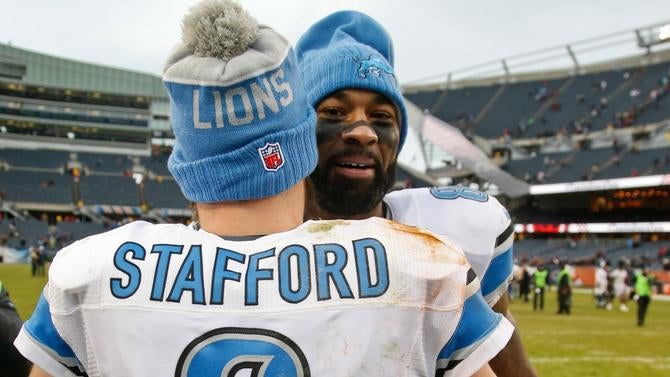 2. They didn't lose Jim Caldwell Jim Caldwell's career record as a head coach is 44-36. Without Peyton Manning as his starter, he's 20-28. Matthew Stafford is not Peyton Manning. 3. Their quarterback is a candidate to regress And that brings us to Stafford, who I'm a bit worried about this year. Stafford is a high-volume passer whose stats often appear better than they are due to the fact that he has averaged close to 40 passes per game in his career. That's nuts -- for context, consider Aaron Rodgers averages 32 and Tom Brady averages roughly 35. Stafford is the definition of mediocre. His career passer-rating sits a hair below 86. This isn't intended to be a huge knock on Stafford -- he can thrive on a complete team that doesn't depend on him to carry the offense. But I'm concerned about the loss of Johnson, who served as Stafford's ideal target. Because Stafford is not a very accurate quarterback, in the sense that he's not precise with his ball placement, a big-bodied receiver like Johnson masked that flaw. With the NFC North getting significantly better this offseason and with the Lions losing the best playmaker in the division, I'd expect Stafford to take a step back. So, that means the Lions are still stuck in quarterback purgatory, in the sense that Stafford is good enough to tempt them into re-signing him when his contract expires at the end of the 2017 season -- because no other viable options will exist on the open market -- but he's not good enough to carry his team. This isn't an issue that will expire at the end of the offseason. It'll last at least for another offseason.
| ||||||||||||||||||
| ||||||||||||||||||
1. Jordy Nelson returns Nobody, not even fantasy owners, missed Jordy Nelson like Aaron Rodgers did. Just look at Rodgers' stat line last year -- a season he went through without Nelson, who tore his ACL in the summer -- compared to 2014:
The problem with the Packers' offense last year, as Pete Prisco wrote about at multiple points, was their dependence on receivers winning in one-on-one coverage. Mike McCarthy and the offensive staff favored isolation routes and the receivers, more often than not, couldn't win single-handedly. Nelson can win against defensive backs and has a history catching passes even when he's not open, like the millions of times he and Rodgers have combined for a back-shoulder sideline completion. And, with Nelson on the field, Randall Cobb can go back to being a secondary option. From 2011 to 2014, Nelson caught 300 passes for 4,841 yards and 43 touchdowns. 2. Eddie Lacy is ripped Another huge issue last season: Eddie Lacy. Lacy carried the ball a career-low 187 times, tied a career-low with 4.1 yards per carry, and rushed for a career-low three touchdowns. His problem was easy to identify: his weight. 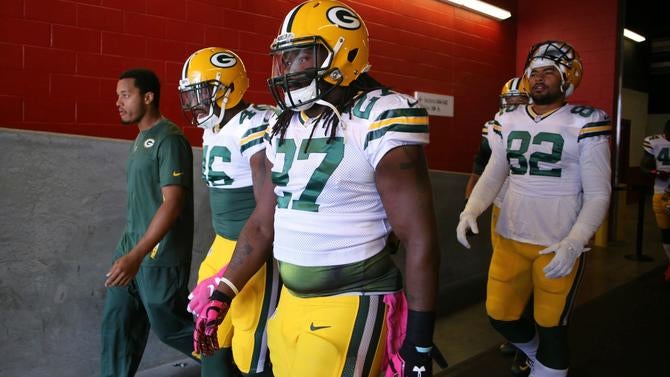 His coach even called him out at the end of the season. "He's got a lot of work to do," McCarthy said, per NFL.com. "His offseason last year was not good enough and he never recovered from it. He cannot play at the weight he played at this year." Now? He looks like this:
If Lacy can get back to his 2014 self, when he averaged 4.6 yards per carry, Rodgers will be able to R-E-L-A-X a bit more. 3. Trevor Davis could be a steal The Packers were lacking a burner a year ago, but they drafted one in the fifth round. By acquiring Trevor Davis from Cal, the Packers gained a legit speedster. At the combine, Davis ran a 4.42 40-yard dash at the combine. For the sake of comparison, Antonio Brown ran a 4.47. In two seasons at Cal, where he caught passes from Jared Goff, Davis averaged 16.7 yards per reception. He should be in the running to win the Packers' return job as well, but I'm more intrigued by the idea of him serving as Rodgers' deep option, even if his route running needs some refining. Three negatives1. Jordy Nelson will be 31 and coming off an ACL tear Sure, Jordy Nelson is back and that's a good thing. But he'll be a 31-year-old receiver coming off a torn ACL. I don't think we can assume Nelson will perform like he did at his peak. 2. They didn't sign Danny Trevathan After the Bears signed Trevathan, the linebacker appeared on NFL Network and revealed that he kind of, maybe, wanted to join the Packers. But they never called him. Trevathan, as previously mentioned, is real good. He's very rangy. He's also young -- just 26. And the Packers have a need for an inside linebacker, because as it stands, Clay Matthews will be required to spend some time in the middle of the field. Matthews is fine as an inside linebacker, but he's a dominant edge-rusher who's better suited in a pass-rushing role. Signing a player of Trevathan's caliber would've helped move Matthews back to the outside. 3. The rest of the division is catching up Per usual, the Packers sat back in free agency and watched every other team spend money on impact players. Their biggest signing? Jared Cook, who'll bring some good and some bad to Green Bay. The Packers' long-standing approach to build through the draft and avoid high-cost players in free agency has served them well -- in large part because they hit a home run on Rodgers, of course -- but that approach means the Packers remained at a standstill while the rest of the NFC North took a step forward this offseason. I'm not certain you can say the Packers got significantly better this offseason. Nelson's return is big, but there's no guarantee he resembles his former self after an ACL tear. After that, where are the upgrades? Draft picks are never a guarantee to work out and the Packers' success meant they were picking near the end of the first round. Meanwhile, the Bears reloaded big-time in free agency and will essentially gain two top-10 players this year ( Kevin White missed all of last year and they took Leonard Floyd this year), the Lions captured the top wideout on the open market, and the Vikings -- who won the NFC North -- still found a way to improve. | ||||||||||||||||||
| ||||||||||||||||||
1. They acquired the perfect receiver for Teddy Bridgewater Not too long before the draft, Laquon Treadwell was regarded as the top receiver in the draft. Somehow, the Vikings got him at No. 23. Clearly, given his draft-night drop, Treadwell's potential is up for debate. What isn't up for debate is how he will fit with Teddy Bridgewater. He's Bridgewater's perfect receiver -- a target who comes down with contested catches and doesn't necessarily need separation to be considered open. Bridgewater isn't great at throwing the deep ball, but Treadwell should help him in the middle of the field and in the red zone, where he struggled to complete passes last season (41 percent completion rate). We've seen what Bridgewater can do with a burner like Mike Wallace (not much). Luckily, the Vikings learned their lesson and provided their young quarterback with Wallace's opposite. 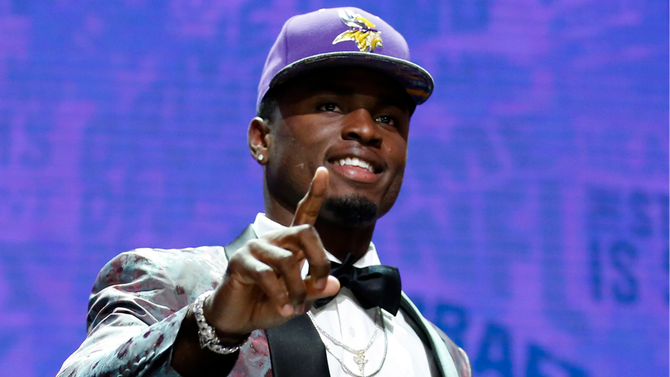 2. They got rid of the worst receiver for Bridgewater Mike Wallace is fast, but he doesn't win contested passes. Teddy Bridgewater is talented, but he doesn't throw the deep ball. And that made Wallace the worst possible fit for the Vikings' offense. He's gone now, though. After a 39-catch, 473-yard, and two-touchdown season, he was released. 3. They signed Andre Smith and Alex Boone One reason why Bridgewater struggled throwing the deep ball? His protection didn't hold up. The Vikings allowed 45 sacks -- tied for the eighth-most in the NFL. So, the Vikings rectified that glaring problem this offseason. Andre Smith is an above-average tackle who should, at the very least, provide some stability on the right side of the line. The Vikings also signed Alex Boone, a dependable run blocker, away from the 49ers. Three negatives1. Adrian Peterson is getting older Peterson will slow down, eventually. He has to, right? He's 31 now. He's logged 2,381 carries and 11,675 yards in his career. At some point, those miles will catch up to him. When it happens, the offense will be in for rough times. As it stands, it's an unbalanced attack. Minnesota finished last season with the fourth-most rushing yards in the league, yet it ended the season as the 29th ranked offense in terms of total yardage. The culprit? A passing game that netted 183 yards per game. Only the Rams were worse through the air. At some point in the near future, the Vikings need Bridgewater to take the next step. 2. Big money spent on aging offensive linemen I'll admit, it's tough to find three areas that were bad for the Vikings this offseason. That's how well they played it. So allow me to play devil's advocate on one of the positives I listed above. They invested $3.5 million in Smith -- a 29-year-old tackle who's been banged up the past two seasons -- and they gave Alex Boone -- another 29-year-old -- $10 million guaranteed. The Vikings now own the most expensive offensive line in all of football, according to Spotrac. The Vikings do not own anywhere close to the best offensive line in football. It definitely looks like the Vikings are overpaying their line. But if it works, no one will care. 3. Cordarrelle Patterson is still a thing Patterson is still on the roster, which means Vikings fans can hope -- one final time -- that he actually turns into a competent receiver, which means they'll eventually be disappointed (again) when he fails (again) to learn the nuances of the position. Since drafting him in the first round before the 2013 season, the Vikings have been rewarded with 80 receptions, 863 yards, and five touchdowns. Last season, he caught two passes. Two. He's been fine as a returner (four touchdowns), but fine returners aren't worth a $2,297,607 cap hit. |







